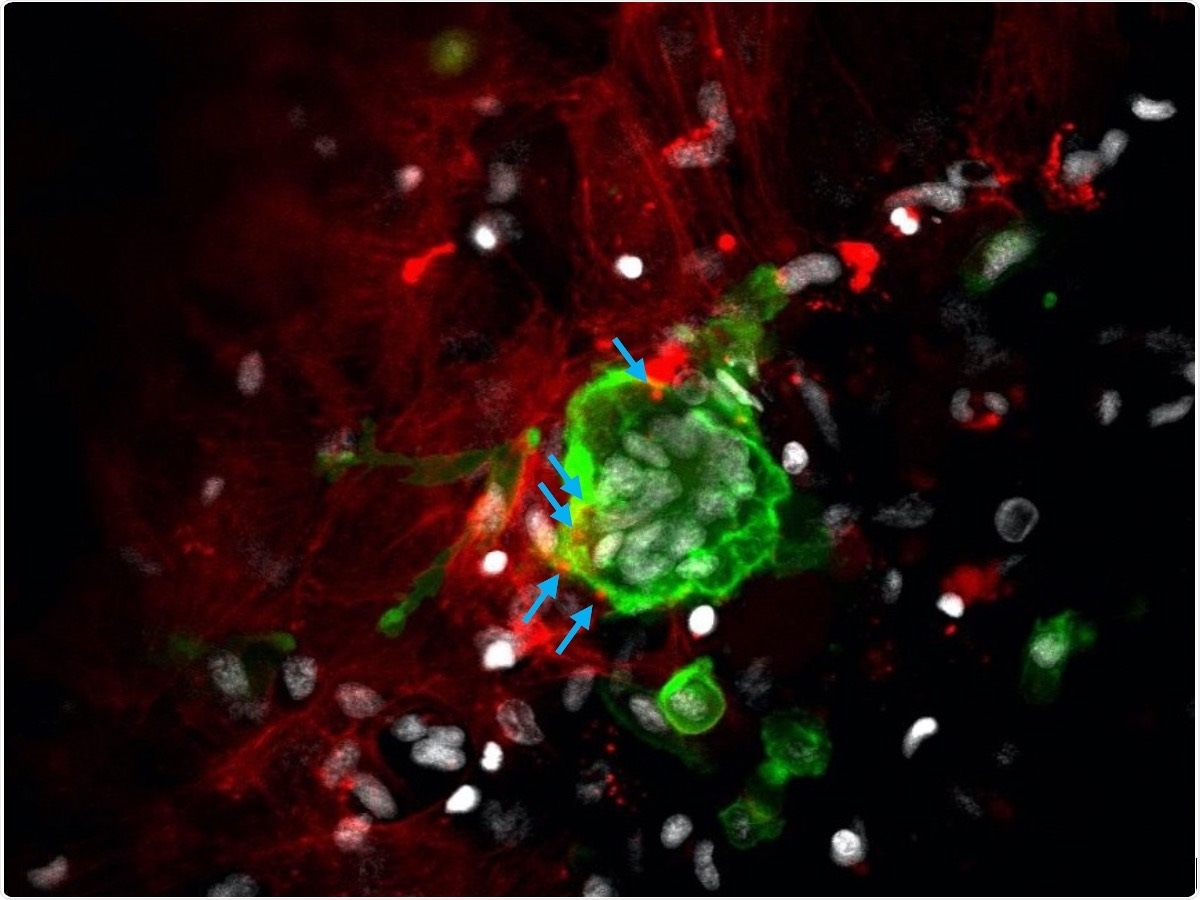A team of researchers, headed by Kanazawa University, has demonstrated that a zebrafish can potentially stop painful genetic and metabolic bone diseases. The study was recently published in the Communications Biology journal.

Osteoclasts and osteoblasts in zebrafish scales were fluorescently labeled with GFP (green) and mCherry (red), respectively. A nucleus is shown in gray. Osteoclasts receive messages from osteoblasts via extracellular vesicles (blue arrows) and fuse to form a multinucleated giant cell in the bone tissue. Image Credit: Kanazawa University.
While immobility, swelling, and pain are the most evident consequences of a broken bone, a range of activities also takes place at the cellular level in an attempt to repair the damage. Since bones are often concealed under layers of skin, muscle, and fat, scientists find it difficult to examine the regeneration process of bones in real time.
To provide insight into the process of fracture repair, we needed bone that was easily accessible and a model species in which bone growth mimicked that of humans. With transgenic and mutant lines already available, zebrafish scales ticked all the boxes.”
Jingjing Kobayashi-Sun, Study Lead Author, Kanazawa University
While the scales of zebrafish are relatively simple compared to mammalian bones, they react and develop in nearly the same manner as their more complex counterparts, and are easily situated outside the body. Most significantly, zebrafish scales contain both osteoblasts and osteoclasts—cells that create new bones after a fracture and remove the broken bone fragments, respectively.
Recent studies have suggested that molecular packages, called extracellular vesicles (EVs), derived from osteoblasts may deliver signaling molecules to immature osteoclasts, triggering their differentiation into mature, active cells. However, given the difficulty of live imaging in bone, no one has been able to prove this process actually occurs in vivo.”
Jingjing Kobayashi-Sun, Study Lead Author, Kanazawa University
To observe the presence of osteoclasts and osteoblasts in zebrafish scales, the scientists created a double transgenic line, where the two types of cells expressed varying color fluorescent labels. When the scientists made tiny cuts in the anesthetized fish scales, they were able to detect the different types of cells in the healing bone through a flow cytometry or fluorescent microscope.
We observed that a large number of the green fluorescent osteoclasts at the fracture site contained red fluorescent osteoblast-derived particles in the cytoplasm, confirming the uptake of EVs by immature osteoclasts. In addition, mature osteoclasts were abundant in the damaged scales, indicating that EV uptake triggers the differentiation of osteoclasts.”
Isao Kobayashi, Study Senior Author, Kanazawa University
The EVs comprised high levels of RANKL, which is a cellular differentiation-associated signaling molecule. When the corresponding gene was knocked out, it caused a considerable reduction in the number of osteoclasts, indicating that the formation of osteoclast is regulated by osteoblasts through Rankl signaling.
Considering that several bone disorders occur due to a breakdown in the interaction between osteoclasts and osteoblasts, such findings offer useful information for developing new drug therapies.
Source:
Journal reference:
Kobayashi-Sun, J., et al. (2020) Uptake of osteoblast-derived extracellular vesicles promotes the differentiation of osteoclasts in the zebrafish scale. Communications Biology. doi.org/10.1038/s42003-020-0925-1.